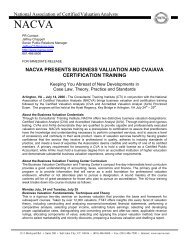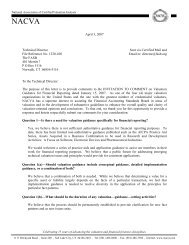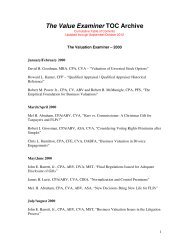VALUATION DISCOUNTS AND PREMIUMS
VALUATION DISCOUNTS AND PREMIUMS
VALUATION DISCOUNTS AND PREMIUMS
Create successful ePaper yourself
Turn your PDF publications into a flip-book with our unique Google optimized e-Paper software.
Fundamentals, Techniques & Theory<strong>VALUATION</strong> <strong>DISCOUNTS</strong> <strong>AND</strong> <strong>PREMIUMS</strong>E. CALCULATION OF TOTAL DISCOUNT APPLICABLE TO A SUBJECT INTERESTThe following example is provided to illustrate the multiplicative calculation of an overalldiscount applicable to a minority interest in a privately held business enterprise.Example:Gross value of entity $1,000X Subject percentage 10%10% Interest (pre discounts) $100Less: Discount for lack of control (30%) (30)Minority, marketable value 70Less: Discount for lack of marketability (20%) (14)Minority, non-marketable value $56Calculation of overall discount: = 1 – [(1-.30) x (1-.20)]= 1 – [(.70) x (.80)]= 1 – .56= .44Overall discount: 44%Note that the total discount in the example is 44 percent, not 50 percent (the sum of the 30percent discount for lack of control and the 20 percent discount for lack of marketability).Although the Courts have erred in this matter of discount application, it is an accepted businessvaluation practice to apply the discounts sequentially.Discounts and premiums can play an important role in the determination of value in a privatelyheld business interest. The type and level of discount and/or premium can depend on numerousfactors as listed in C above.Almost universally accepted is the concept of four levels of value from which adjustments canbe made via discounts and premiums to attain the correct conclusion, given the specificcharacteristics of the ownership interest under valuation.II. CONTROL PREMIUM <strong>AND</strong> MINORITY INTEREST BASICSOf all the intrinsic characteristics related to an equity interest, arguably none may be more importantthan the element of control. Widely accepted theory within the business valuation community holdsthat an investment in a privately held company is worth the present value of all of the future benefitsinuring to the holder of that equity interest. Clearly, then, if the equity holder has a control position,he or she can accelerate the receipt of those future benefits and via management and operationalinitiatives, take direct steps to enhance the future benefits, or at least the probability that they will begenerated.On the other hand, a minority or non-controlling position in a privately held company is generallyheld at the great risk of being subject to the judgment, ethics and management skills of thecontrolling shareholder(s). Depending on a number of items, the impairment of value can besignificant in this circumstance.© 1995–2012 by National Association of Certified Valuators and Analysts (NACVA). All rights reserved. Chapter Seven – 5Used by Institute of Business Appraisers with permission of NACVA for limited purpose of collaborative training. 2012.v1















